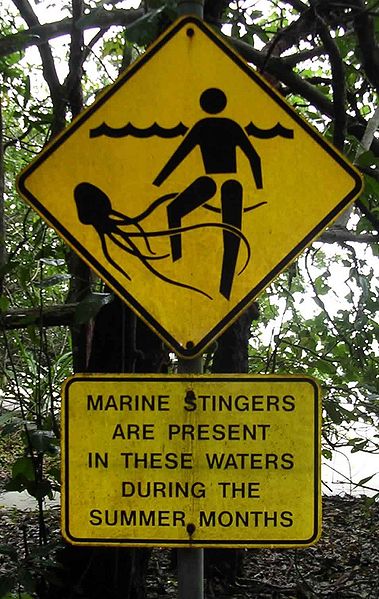Interactions with Other Species
Hawaiian Box Jellyfish (Carybdea alata) are known for their negative interactions with
humans due to their acute stings (Nomura, et al 2002). This is
most apparent in the Hawaiian and Australian coastal areas due
to their monthly spawning that occurs.
Every eight to nine days after a full moon the spawning
occurs and a massive number of these jellyfish crowd the coast
(Nagai, et al. 2000) causing a highly increased number of
reported painful stings (Tamanaha, et al 1996). This invasion of
Hawaiian Box Jellyfish has become a serious problem for the
tourism of many coastal areas of Hawaii and Australia,
especially Oahu, Hawaii. At the Waikiki Beach in Oahu these
jellyfish have caused various public health problems with their
stings. In fact the Hawaiian Box Jellyfish sting is known to be
one of the most severe stings in Hawaiian Costal waters due to
its large range of side effects (Yanagihara, et al 2001).
The less serious side effects of
a Hawaiian Box Jellyfish sting include hives, swelling, and muscle
weakness (Chung, et al 2001). The more life threatening effects are
difficulty breathing, paresthesia, and shock (Chung, et al 2001), but
luckily there have not yet been any reported deaths (Tamanaha, et al
1996). The pattern of sting that
this jellyfish leaves is normally an annular or ladder like pelt which
is good to be able to distinguish from the extremely poisonous
Chironex fleckeri jellyfish
sting which appears to be a whip like linear markings. To find out more
about other organisms related to Carybdea alata visit
Classification. The venom that
Hawaiian Box Jellyfish produces is hard to characterize but it appears to
contain a bioactive hemolytic protein which seems to be reduced by the
enzymes papain, collagenase, and trypsin (Nomura, et al 2002). Other
treatments include heat, vinegar, and meat tenderizer which reduce the swelling.
A couple other examples of jelly fish stings are  Cyanea
capillate and
Irukandji Jellyfish.
Cyanea
capillate and
Irukandji Jellyfish.
Hawaiian Box Jellyfish sting humans as a defense mechanism along with its other ocean predators such as batfish, butterfish, and crabs. Sea turtles like the Green Turtle are also a major predator, but they are not affected by venomous stings (Marsh, et al 2010). Besides using their tentacles to void off predators, Carybdea alata also use them to stun prey. They do this by extending their stinging tentacles to capture prey and then ingest it (Yanagihara, et al 2001). They eat every day and quite frequently consisting generally of crustaceans and smaller fish like the Stegastes planifrons which are easily grasped by the tentacles (Soto, T.D. 2013). Hawaiian Box Jellyfish’s preferred prey is small shrimp because they are easily captured and contain a good amount of nutrients. Over all Hawaiian Box Jellyfish are thriving organisms that are higher up on the food chain due to their venomous tentacles, which also negatively affect humans (Yanagihara, et al 2001).
.
